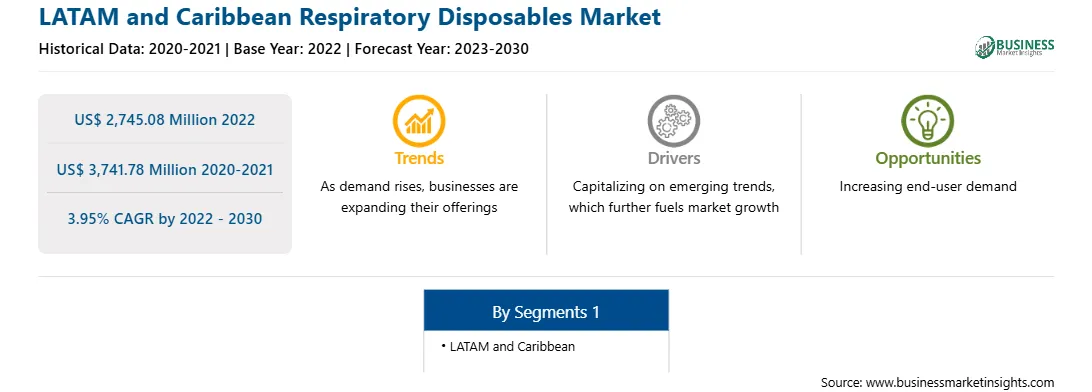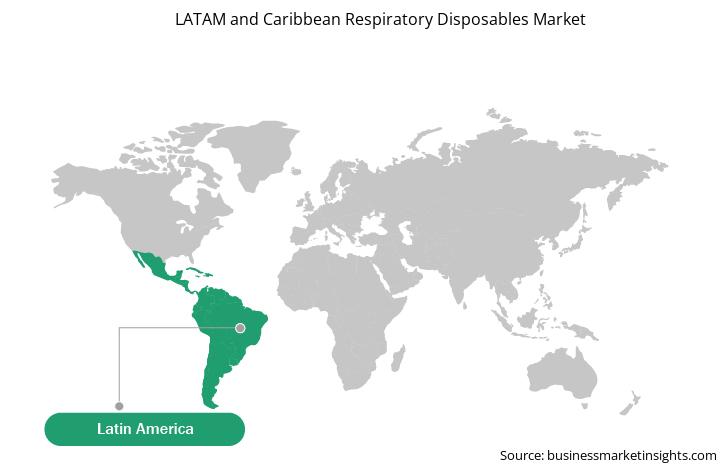According to our new research study on "LATAM and Caribbean Respiratory Disposables Market Forecasts (2020-2030), Country Share, Trends, and Growth Opportunity Analysis - by Products, Clinical Indications, Usage, and End User," the market was valued at US$ 2,745.08 million in 2022 and is expected to reach US$ 3,741.78 million by 2030. It is estimated to register a CAGR of 3.95% from 2022 to 2030.
Respiratory disposables are consumables used to interface with respiratory devices such as ventilators, nebulizers, and oxygen therapy machines. Respiratory supplies include disposable tubes, disposable oxygen masks, disposable ventilators, and other accessories. Healthcare professionals use disposable respirators during procedures to protect both the patient and healthcare staff from the transmission of microorganisms, body fluids, and particulate matter. Respiratory disposables are used to treat respiratory diseases such as asthma, chronic obstructive pulmonary disease (COPD), and sleep apnea. In addition, they save time, reduce the economic burden on hospitals, and prevent infections. Therefore, there is increasing demand in Latin American and Caribbean countries. In addition, the prevalence of respiratory diseases such as COPD, tuberculosis, asthma, and sleep apnea is increasing due to various reasons such as air pollution, occupational chemicals and dust, frequent lower respiratory tract infections in childhood, and other environmental factors. Therefore, the expected increase in the number of patients suffering from COPD, a serious public health problem, is expected to increase the demand for effective respiratory supplies such as oxygen masks, nebulizers, and others, thereby driving the growth of the segment.
Many studies have shown a significant rise in healthcare expenditure in LATAM. According to a study published by Global Health Intelligence (GHI) in March 2022, ~75% of hospitals in Latin America increased their budgets to import medical supplies and consumables. In Latin America, Brazil has reported that more than a quarter of hospitals have increased the use of consumables. According to the data collected by the International Trade Administration, in March 2023, Brazil accounted for the largest healthcare market in Latin America, with healthcare spending of 9.1% of GDP. In 2021, 532,645 hospital beds, 88,000 healthcare auxiliary services, and 502,000 physicians were reported in the country.
Similarly, there is an increase in investments in medical equipment by the key countries in the regions. For instance, per the statistics released by the US Census Bureau in 2021, Brazil was the 14th largest market for medical equipment in the US and the second largest in Latin America, after Mexico. Medical devices exported from the US to Brazil were worth US$ 947 million. During 2020-2021, Colombia, Chile, and Argentina increased their investments in the medical sector, and they started purchasing and improving healthcare infrastructure in 2022. The Argentine government increased its investments by 8.7% in 2021 during the COVID-19 pandemic and reached 11% in 2022. Also, the countries in the region are the largest importers of medical consumables. Thus, the investments to increase medical infrastructure have led to increased import of medical consumables, including respiratory disposables such as masks, disposable respirators and breathing circuits, breathing bags and tubes, and nasal cannulas. Thus, rising investments in medical consumables and devices drive the LATAM and Caribbean respiratory disposables market.
Governments of several countries in Latin America have increased the per capita consumption of disposable masks owing to the growing prevalence of infectious respiratory diseases in the region. Over the past few years, the number of patients suffering from respiratory disorders such as chronic pulmonary respiratory disease, asthma, and tuberculosis has increased. According to an article published by BMC Pulmonary Medicine in July 2022, a study was carried out to analyze the prevalence of chronic obstructive pulmonary disease (COPD) in Latin America and the Caribbean countries. The inclusion criteria were met by twenty studies (nineteen cross-sectional and one cohort), which concluded that COPD was found in 8.9% of the general population over the age of 35. Men had a prevalence of 13.7%, while women had a prevalence of 6.7%. The frequency was 24.3% among smokers and ex-smokers.
Similarly, asthma is a common respiratory disease in Latin America, which has a population of 603 million people. Per an article published by Taylor & Francis Online in 2021, the estimated average prevalence of asthma is 17%, varying widely across cities, with Costa Rica recording a prevalence of 30%. Furthermore, the risk of severe exacerbations seems to be higher in Latin America than in other regions. Disposable face masks are critical in reducing the spread of respiratory infections due to their ability to filter airborne pathogens. The article published by ScienceDirect in August 2023 stated that ~255 million masks per month were used in Latin American countries, including Brazil, Argentina, and Colombia.
Moreover, the medical industry's growth escalated due to increasing medical tourism and the growing number of healthcare facility centers, leading to high demand for respiratory disposables. As a result, companies are witnessing regional growth opportunities and expanding their distribution network in Latin America. Thus, the growing prevalence of respiratory diseases is anticipated to create several opportunities for the LATAM and Caribbean respiratory disposables market during the forecast period.
By Product, LATAM and Caribbean Respiratory Disposables Market-Based Insights
Based on product, the LATAM and Caribbean respiratory disposables market is segmented into masks and respirators, resuscitators, nasal cannulas, nebulizers, laryngoscopes, and others. The masks and respirators segment held the largest market share in 2022. However, the laryngoscope segment is anticipated to register the highest CAGR of 8.29% from 2022 to 2030.
Masks and respirators are used to protect the wearer from droplets, airborne particles, and body fluids that might potentially be harmful to the skin. They are loose-fitting and disposable, which makes breathing easy and comfortable. In the masks, the filter material combines various high-performance filter media to achieve excellent filter performance. The various filter layers retain the coarse and fine particles effectively. At the same time, the breathing resistance remains extremely low so that the user can work easily and without fatigue, even for longer periods. Odor-stopping versions of the masks and respirators use an additional layer of internal activated carbon to combat unpleasant odors. Ventilators are also used in a variety of healthcare settings, such as hospitals and emergency facilities, for patient ventilation and oxygen therapy. The increase in the geriatric population and the rise in the prevalence of respiratory diseases are expected to boost the demand for masks and respirators. A few of the commonly available respirators are N95, N99, N100, P95, P99, P100, R95, R99, and R100.
By Usage, LATAM and Caribbean Respiratory Disposables Market-Based Insights
Based on usage, the LATAM and Caribbean respiratory disposables market is segmented into neonatal and pediatrics, adults, and geriatrics. The geriatrics segment held the largest market share in 2022; however, the adults segment is anticipated to register the highest CAGR of 4.56% from 2022 to 2030.
An increase in the geriatric population in LATAM countries and the weakening of the immune system in the elderly population make this population vulnerable to respiratory diseases. Respiratory diseases and conditions, including pneumonia, chronic obstructive pulmonary disease (COPD), and sleep apnea, become more common with age. Due to normal aging processes and cumulative exposure to environmental factors, the older population is more susceptible to these diseases. Therefore, they require a variety of disposable respiratory devices, such as inhalers, nebulizers, and oxygen therapy devices. The age for adult patients ranges from 18 to 60 years. The adult population is vulnerable to several respiratory diseases, which can be parenchymal lung diseases, chronic diseases, asthma, occupational lung diseases, chronic obstructive pulmonary disease (COPD), and acute illnesses such as pneumonia and flu.
The World Health Organization (WHO), International Liaison Committee On Resuscitation (ILCOR), United Nations International Children's Fund (UNICEF), Centers for Disease Control and Prevention (CDC), Pan America Health Organization (PAHO) are a few of the major primary and secondary sources referred to while preparing the report on the LATAM and Caribbean respiratory disposables market.
Strategic insights for the LATAM and Caribbean Respiratory Disposables provides data-driven analysis of the industry landscape, including current trends, key players, and regional nuances. These insights offer actionable recommendations, enabling readers to differentiate themselves from competitors by identifying untapped segments or developing unique value propositions. Leveraging data analytics, these insights help industry players anticipate the market shifts, whether investors, manufacturers, or other stakeholders. A future-oriented perspective is essential, helping stakeholders anticipate market shifts and position themselves for long-term success in this dynamic region. Ultimately, effective strategic insights empower readers to make informed decisions that drive profitability and achieve their business objectives within the market.

| Report Attribute | Details |
|---|---|
| Market size in 2022 | US$ 2,745.08 Million |
| Market Size by 2030 | US$ 3,741.78 Million |
| Global CAGR (2022 - 2030) | 3.95% |
| Historical Data | 2020-2021 |
| Forecast period | 2023-2030 |
| Segments Covered |
By LATAM and Caribbean |
| Regions and Countries Covered | LATAM & Caribbean
|
| Market leaders and key company profiles |
The geographic scope of the LATAM and Caribbean Respiratory Disposables refers to the specific areas in which a business operates and competes. Understanding local distinctions, such as diverse consumer preferences (e.g., demand for specific plug types or battery backup durations), varying economic conditions, and regulatory environments, is crucial for tailoring strategies to specific markets. Businesses can expand their reach by identifying underserved areas or adapting their offerings to meet local demands. A clear market focus allows for more effective resource allocation, targeted marketing campaigns, and better positioning against local competitors, ultimately driving growth in those targeted areas.

The List of Companies - LATAM and Caribbean Respiratory Disposables Market
- 3M
- Fisher & Paykel Healthcare
- Medtronic
- Dr?gerwerk AG & Co. KGaA
- GE HealthCare
- Masimo Corporation
- Koninklijke Philips NV
- ResMed
- Intersurgical Ltd.
- Ambu A/S
The LATAM and Caribbean Respiratory Disposables Market is valued at US$ 2,745.08 Million in 2022, it is projected to reach US$ 3,741.78 Million by 2030.
As per our report LATAM and Caribbean Respiratory Disposables Market, the market size is valued at US$ 2,745.08 Million in 2022, projecting it to reach US$ 3,741.78 Million by 2030. This translates to a CAGR of approximately 3.95% during the forecast period.
The LATAM and Caribbean Respiratory Disposables Market report typically cover these key segments-
The historic period, base year, and forecast period can vary slightly depending on the specific market research report. However, for the LATAM and Caribbean Respiratory Disposables Market report:
The LATAM and Caribbean Respiratory Disposables Market is populated by several key players, each contributing to its growth and innovation. Some of the major players include:
The LATAM and Caribbean Respiratory Disposables Market report is valuable for diverse stakeholders, including:
Essentially, anyone involved in or considering involvement in the LATAM and Caribbean Respiratory Disposables Market value chain can benefit from the information contained in a comprehensive market report.